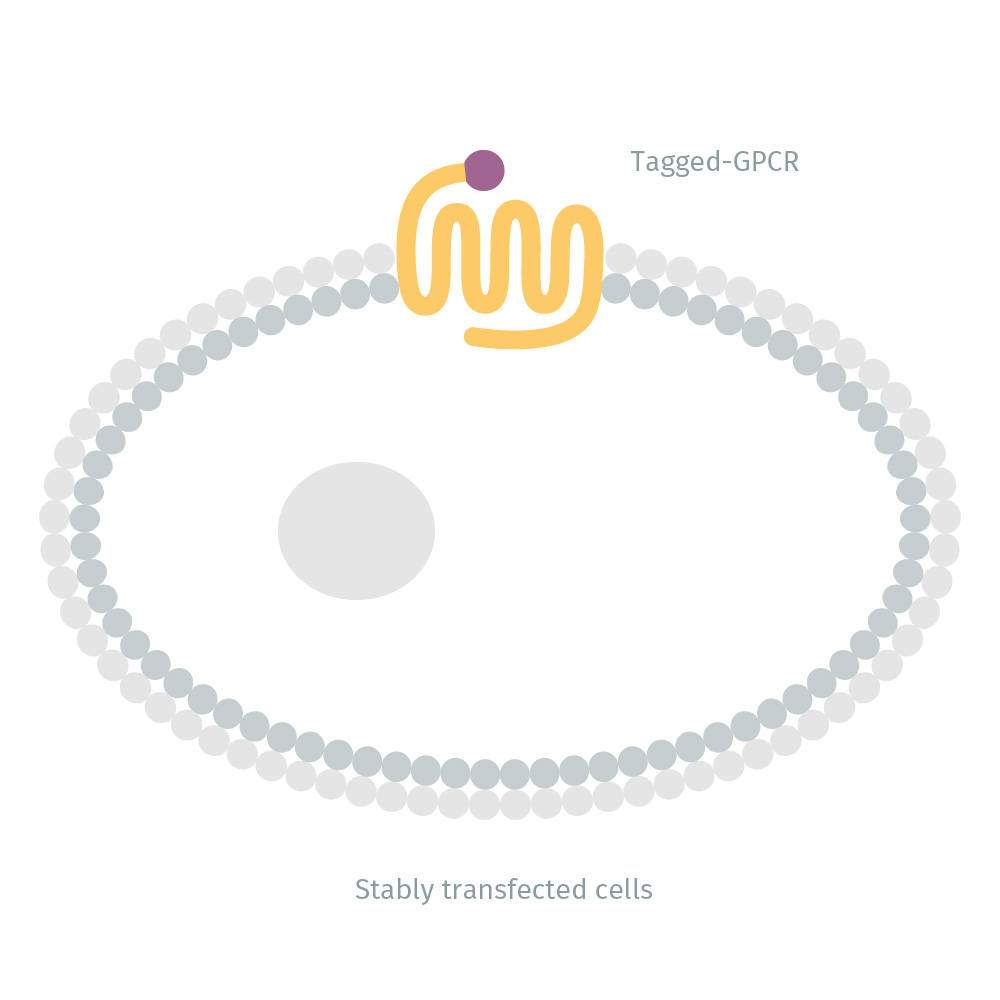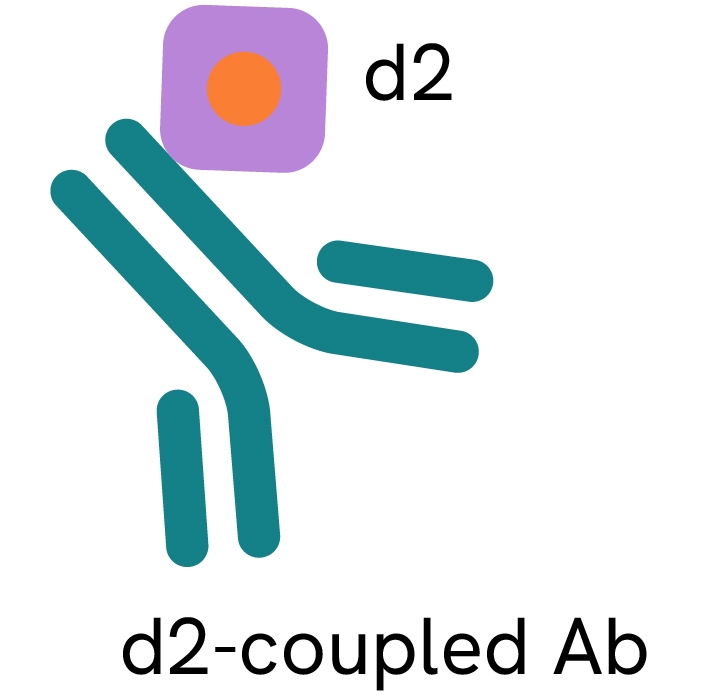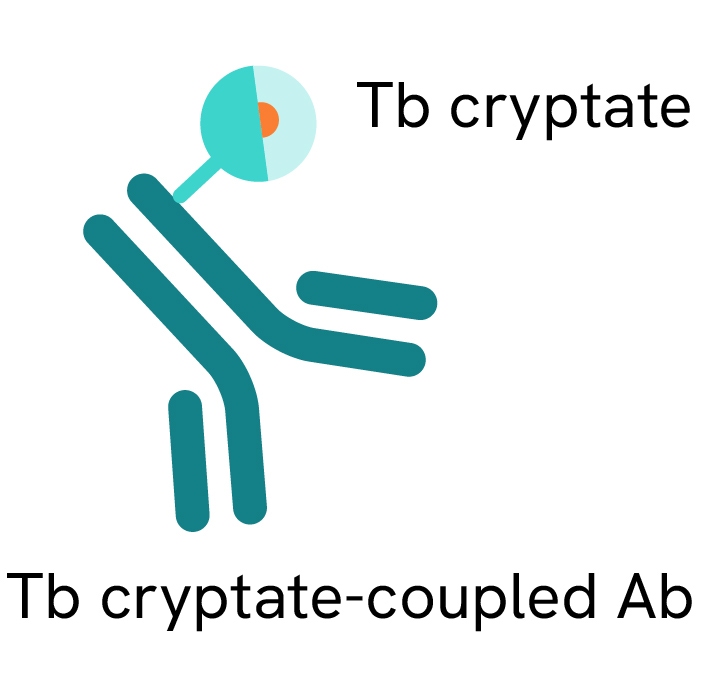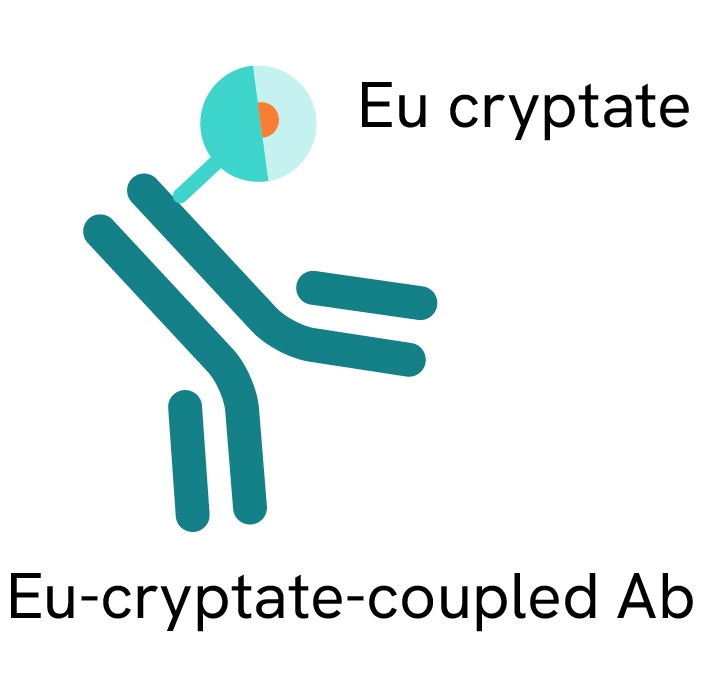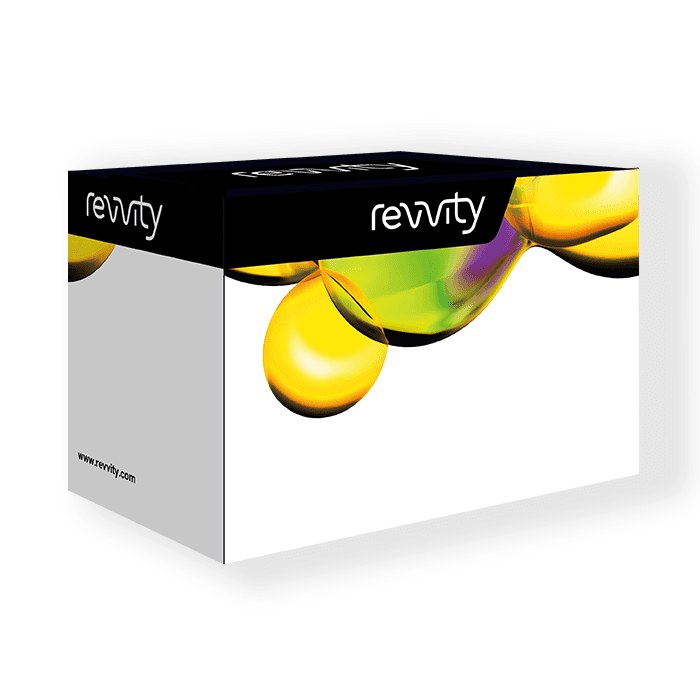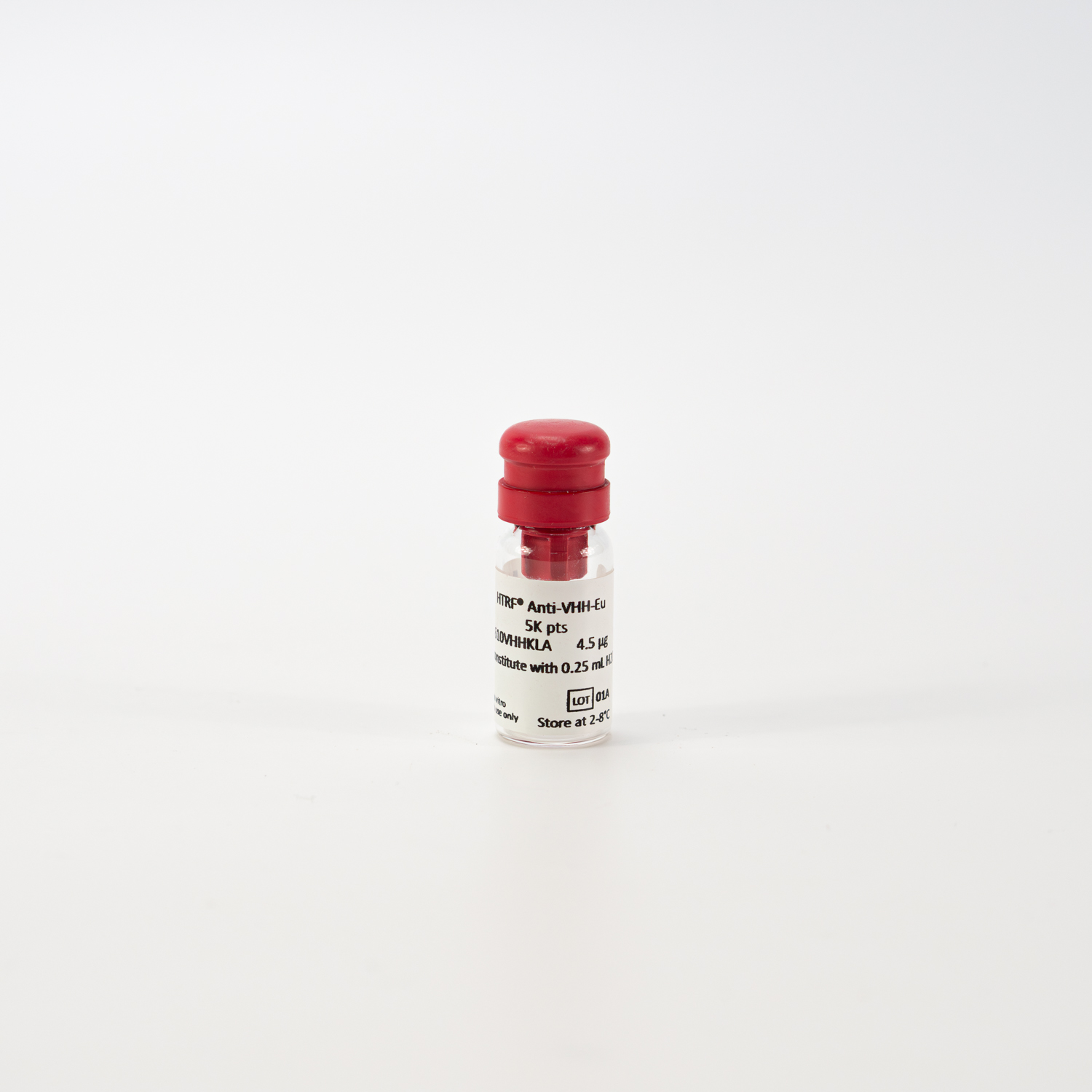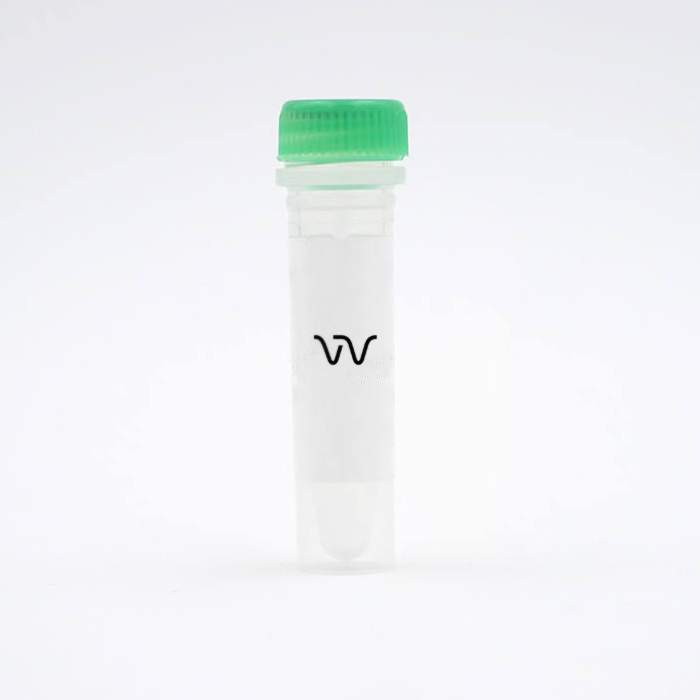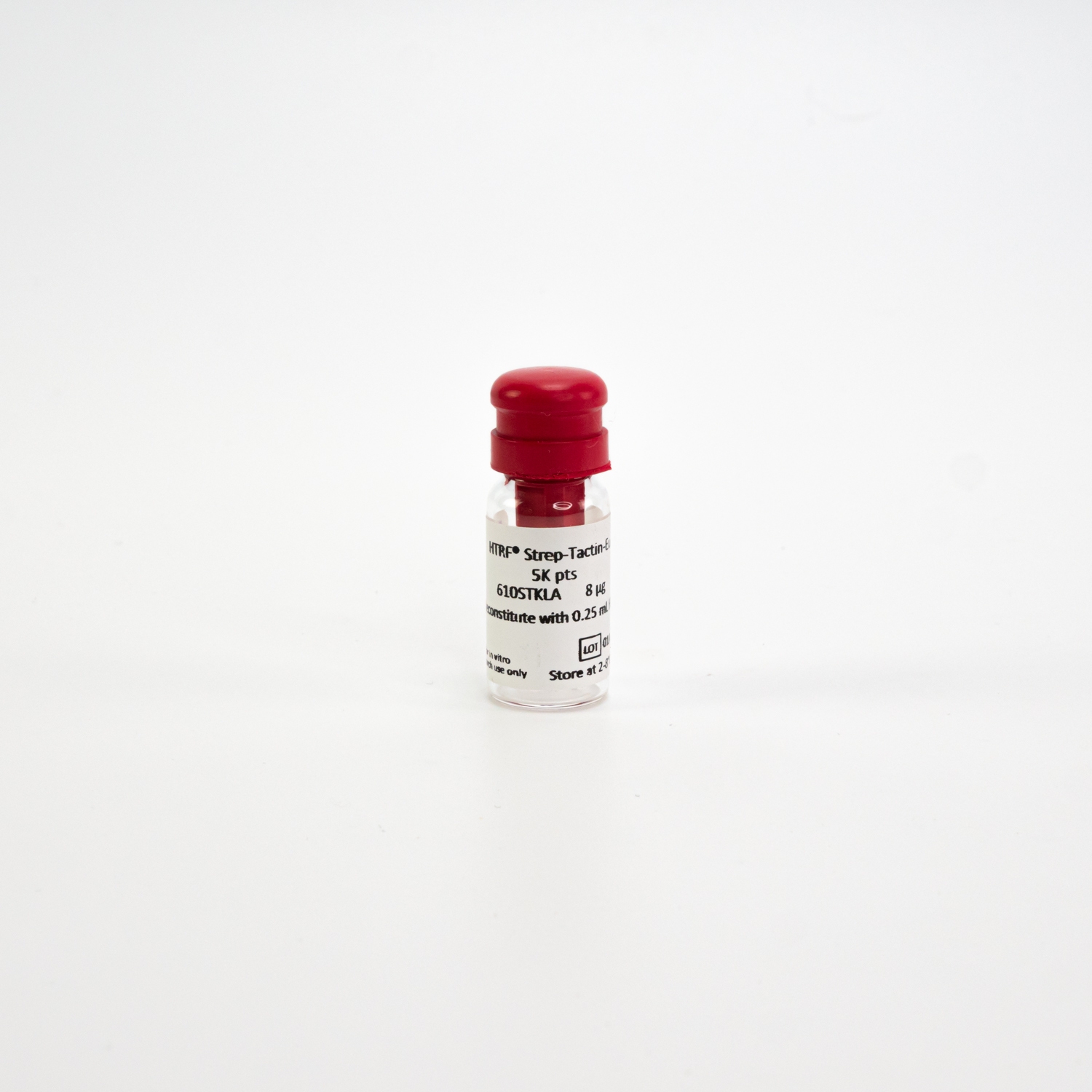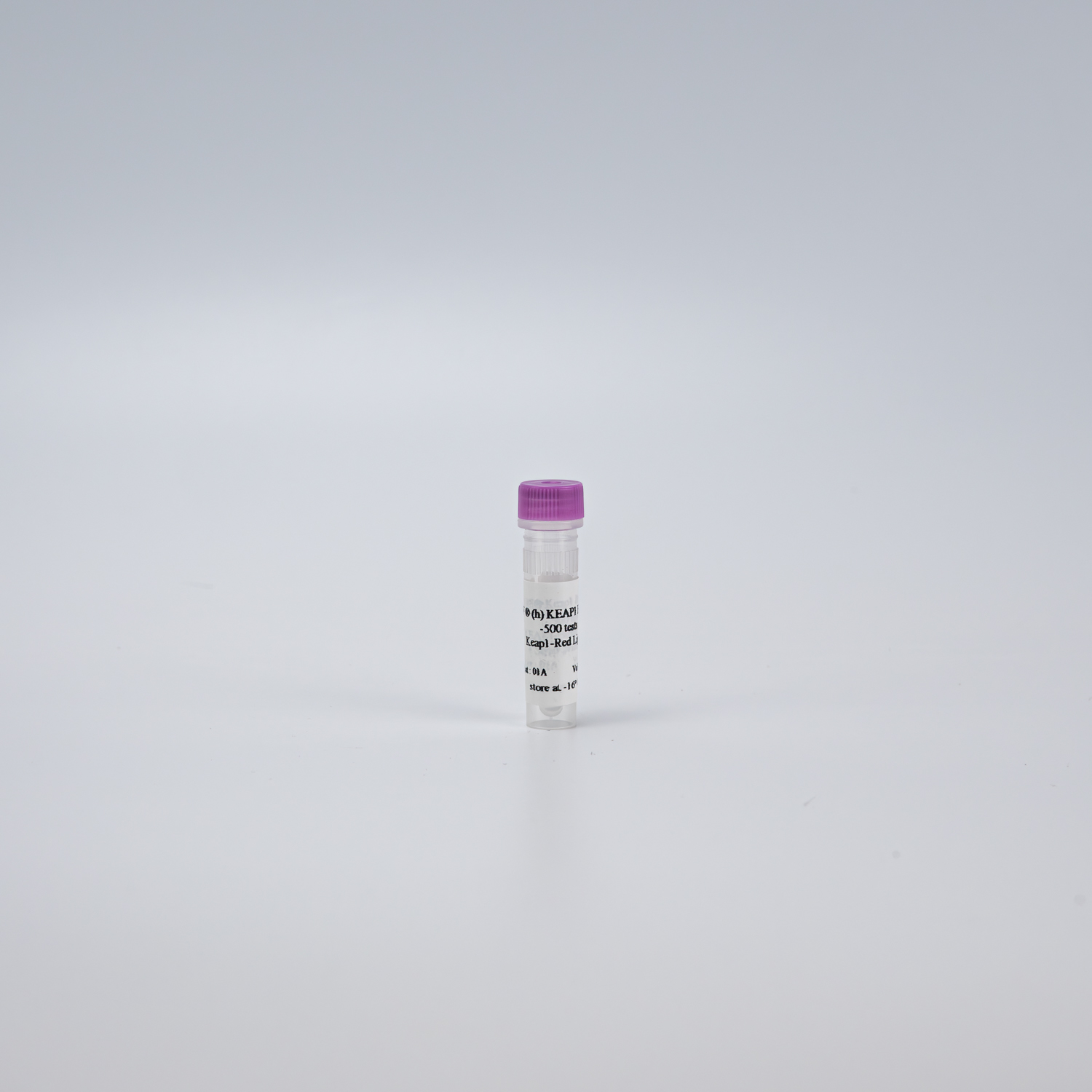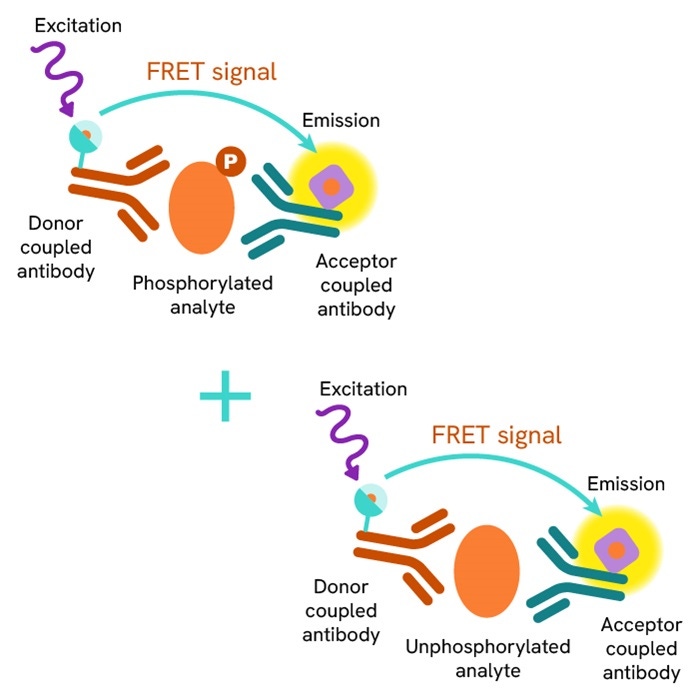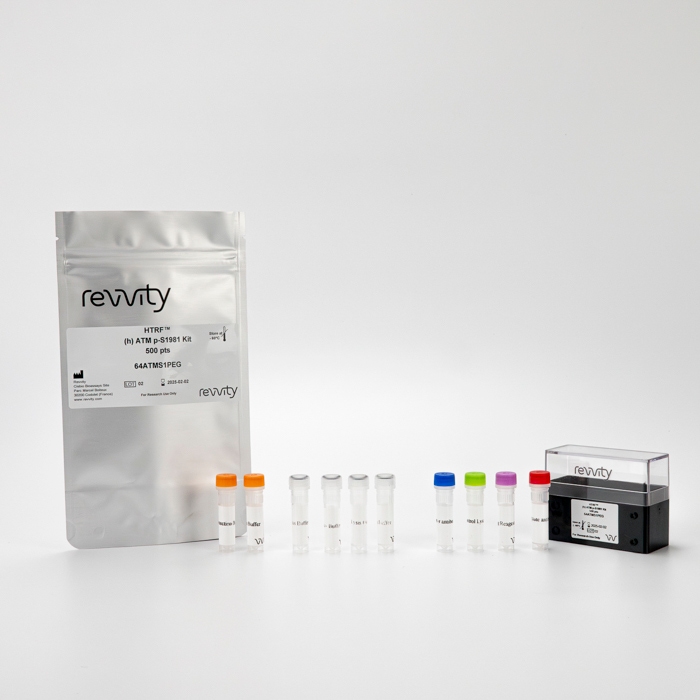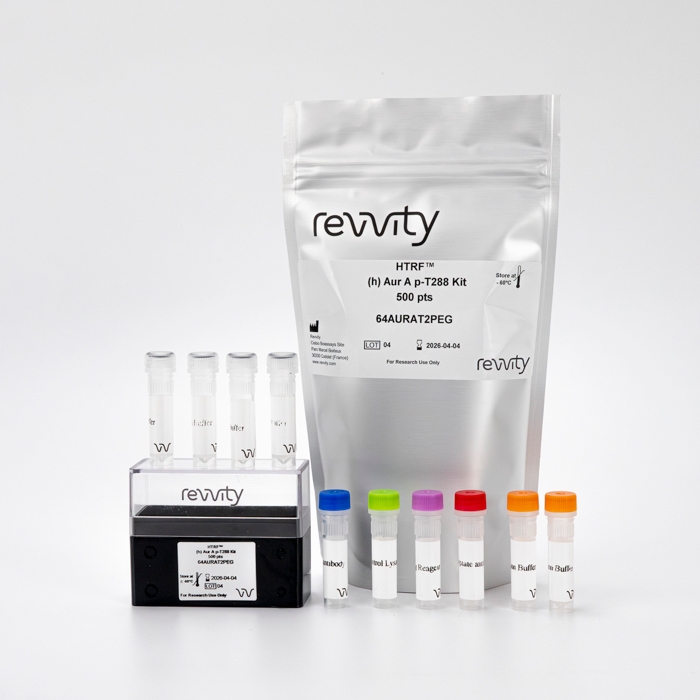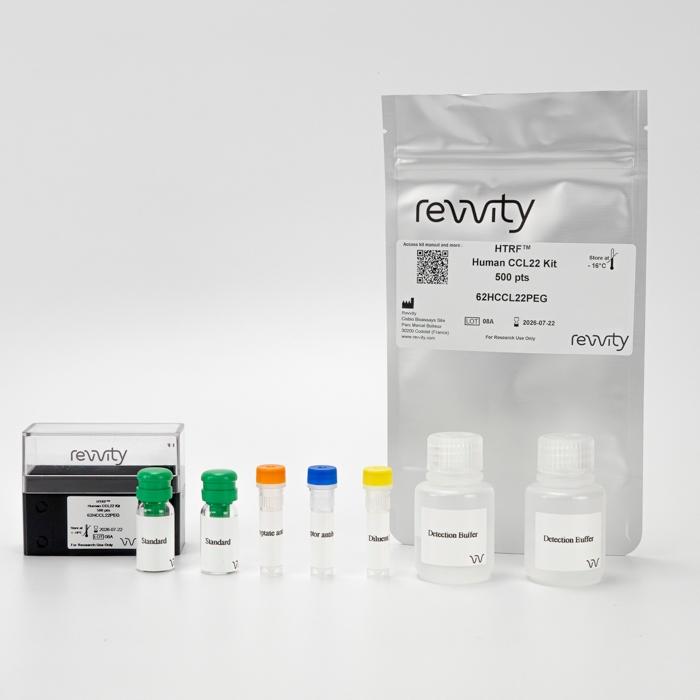Virus blockade assay

Adapted from Newton et al. / Journal of Biomolecular Screening 18(3) (2012) 237–246.
A wide range of biomolecular interactions can be assessed
The advances in identifying short primary sequences mostly involved in the PPI interfaces, also called hot-spots, have greatly facilitated the setup of biochemical assays to identify PPI modulators. However in some projects the binding epitopes involved in PPI interfaces are not fully understood, which requires the use of full size proteins to reproduce the interaction and screen for inhibitors or stabilizers.
HTRF is a popular technology for PPIs, whatever the molecular weight of your protein partners, as illustrated below:

Large size complex
B-Catenin/TCF4
This study was performed to show the ability of HTRF PPI reagents to address large biomolecular interactions. Recombinant human GST-β-Catenin (115 KDa) and 6HIS-TCF4 (55 KDa) interaction was detected using Anti GST-Eu Cryptate (150 KDa) and Anti 6HIS-d2 (150 KDa) antibodies.
HTRF is suitable for low to high affinity interactions
Protein-Protein interaction networks are extended and complex. They are also conveyed by a vast number of non-covalent binding modes. This diversity results in a wide range of affinities from very weak and transient interactions to very strong (High µM to picomolar).
The reliability of HTRF, coupled with a wide diversity of PPI tools, helps to enable the efficient measurement of complex interactions displaying low to high Kd.
HTRF PPI assays taken from published papers, displaying a large panel of affinities.

Let’s see how to get started with your own PPI!
-
Choose your target interaction
Receptor/ligands, RNA, DNA, lipids, enzymes, etc. Any interacting proteins are within your reach: It’s all about what you want!
-
Select assay format & starting material
Antibodies, native partner, biotinylated partner, tagged protein, Fc fused proteins matching your goals.
-
Choose your detection reagents
46 options ensure that you find a match for your interaction: labeling kits, affinity reagents, detection and anti species reagents.
-
Assay optimization and data processing
A single optimization step to adjust reagents to each other.
And off to the reader you go!
Receptor-Ligand binding assay

Adapted from C J. Rossant / Journal of Biomolecular Screening 2015, Vol. 20(4) 508–518
A wide range of biomolecular interactions can be assessed
The advances in identifying short primary sequences mostly involved in the PPI interfaces, also called hot-spots, have greatly facilitated the setup of biochemical assays to identify PPI modulators. However in some projects the binding epitopes involved in PPI interfaces are not fully understood, which requires the use of full size proteins to reproduce the interaction and screen for inhibitors or stabilizers.
HTRF is a popular technology for PPIs, whatever the molecular weight of your protein partners, as illustrated below:

Large size complex
B-Catenin/TCF4
This study was performed to show the ability of HTRF PPI reagents to address large biomolecular interactions. Recombinant human GST-β-Catenin (115 KDa) and 6HIS-TCF4 (55 KDa) interaction was detected using Anti GST-Eu Cryptate (150 KDa) and Anti 6HIS-d2 (150 KDa) antibodies.
HTRF is suitable for low to high affinity interactions
Protein-Protein interaction networks are extended and complex. They are also conveyed by a vast number of non-covalent binding modes. This diversity results in a wide range of affinities from very weak and transient interactions to very strong (High µM to picomolar).
The reliability of HTRF, coupled with a wide diversity of PPI tools, helps to enable the efficient measurement of complex interactions displaying low to high Kd.
HTRF PPI assays taken from published papers, displaying a large panel of affinities.

Let’s see how to get started with your own PPI!
-
Choose your target interaction
Receptor/ligands, RNA, DNA, lipids, enzymes, etc. Any interacting proteins are within your reach: It’s all about what you want!
-
Select assay format & starting material
Antibodies, native partner, biotinylated partner, tagged protein, Fc fused proteins matching your goals.
-
Choose your detection reagents
46 options ensure that you find a match for your interaction: labeling kits, affinity reagents, detection and anti species reagents.
-
Assay optimization and data processing
A single optimization step to adjust reagents to each other.
And off to the reader you go!
mRNA/Protein binding assay

Adapted from M.D.Disney et al. / ACS Chem Biol. 2012 October 19; 7(10): 1711–1718
A wide range of biomolecular interactions can be assessed
The advances in identifying short primary sequences mostly involved in the PPI interfaces, also called hot-spots, have greatly facilitated the setup of biochemical assays to identify PPI modulators. However in some projects the binding epitopes involved in PPI interfaces are not fully understood, which requires the use of full size proteins to reproduce the interaction and screen for inhibitors or stabilizers.
HTRF is a popular technology for PPIs, whatever the molecular weight of your protein partners, as illustrated below:

Large size complex
B-Catenin/TCF4
This study was performed to show the ability of HTRF PPI reagents to address large biomolecular interactions. Recombinant human GST-β-Catenin (115 KDa) and 6HIS-TCF4 (55 KDa) interaction was detected using Anti GST-Eu Cryptate (150 KDa) and Anti 6HIS-d2 (150 KDa) antibodies.
HTRF is suitable for low to high affinity interactions
Protein-Protein interaction networks are extended and complex. They are also conveyed by a vast number of non-covalent binding modes. This diversity results in a wide range of affinities from very weak and transient interactions to very strong (High µM to picomolar).
The reliability of HTRF, coupled with a wide diversity of PPI tools, helps to enable the efficient measurement of complex interactions displaying low to high Kd.
HTRF PPI assays taken from published papers, displaying a large panel of affinities.

Let’s see how to get started with your own PPI!
-
Choose your target interaction
Receptor/ligands, RNA, DNA, lipids, enzymes, etc. Any interacting proteins are within your reach: It’s all about what you want!
-
Select assay format & starting material
Antibodies, native partner, biotinylated partner, tagged protein, Fc fused proteins matching your goals.
-
Choose your detection reagents
46 options ensure that you find a match for your interaction: labeling kits, affinity reagents, detection and anti species reagents.
-
Assay optimization and data processing
A single optimization step to adjust reagents to each other.
And off to the reader you go!
Antibody epitope mapping

Adapted from C J. Rossant / Journal of Biomolecular Screening 2015, Vol. 20(4) 508–518
A wide range of biomolecular interactions can be assessed
The advances in identifying short primary sequences mostly involved in the PPI interfaces, also called hot-spots, have greatly facilitated the setup of biochemical assays to identify PPI modulators. However in some projects the binding epitopes involved in PPI interfaces are not fully understood, which requires the use of full size proteins to reproduce the interaction and screen for inhibitors or stabilizers.
HTRF is a popular technology for PPIs, whatever the molecular weight of your protein partners, as illustrated below:

Large size complex
B-Catenin/TCF4
This study was performed to show the ability of HTRF PPI reagents to address large biomolecular interactions. Recombinant human GST-β-Catenin (115 KDa) and 6HIS-TCF4 (55 KDa) interaction was detected using Anti GST-Eu Cryptate (150 KDa) and Anti 6HIS-d2 (150 KDa) antibodies.
HTRF is suitable for low to high affinity interactions
Protein-Protein interaction networks are extended and complex. They are also conveyed by a vast number of non-covalent binding modes. This diversity results in a wide range of affinities from very weak and transient interactions to very strong (High µM to picomolar).
The reliability of HTRF, coupled with a wide diversity of PPI tools, helps to enable the efficient measurement of complex interactions displaying low to high Kd.
HTRF PPI assays taken from published papers, displaying a large panel of affinities.

Let’s see how to get started with your own PPI!
-
Choose your target interaction
Receptor/ligands, RNA, DNA, lipids, enzymes, etc. Any interacting proteins are within your reach: It’s all about what you want!
-
Select assay format & starting material
Antibodies, native partner, biotinylated partner, tagged protein, Fc fused proteins matching your goals.
-
Choose your detection reagents
46 options ensure that you find a match for your interaction: labeling kits, affinity reagents, detection and anti species reagents.
-
Assay optimization and data processing
A single optimization step to adjust reagents to each other.
And off to the reader you go!
Protease assay

Ingo H. Engels et al. / Analytical Biochemistry 390 (2009) 85–87
A wide range of biomolecular interactions can be assessed
The advances in identifying short primary sequences mostly involved in the PPI interfaces, also called hot-spots, have greatly facilitated the setup of biochemical assays to identify PPI modulators. However in some projects the binding epitopes involved in PPI interfaces are not fully understood, which requires the use of full size proteins to reproduce the interaction and screen for inhibitors or stabilizers.
HTRF is a popular technology for PPIs, whatever the molecular weight of your protein partners, as illustrated below:

Large size complex
B-Catenin/TCF4
This study was performed to show the ability of HTRF PPI reagents to address large biomolecular interactions. Recombinant human GST-β-Catenin (115 KDa) and 6HIS-TCF4 (55 KDa) interaction was detected using Anti GST-Eu Cryptate (150 KDa) and Anti 6HIS-d2 (150 KDa) antibodies.
HTRF is suitable for low to high affinity interactions
Protein-Protein interaction networks are extended and complex. They are also conveyed by a vast number of non-covalent binding modes. This diversity results in a wide range of affinities from very weak and transient interactions to very strong (High µM to picomolar).
The reliability of HTRF, coupled with a wide diversity of PPI tools, helps to enable the efficient measurement of complex interactions displaying low to high Kd.
HTRF PPI assays taken from published papers, displaying a large panel of affinities.

Let’s see how to get started with your own PPI!
-
Choose your target interaction
Receptor/ligands, RNA, DNA, lipids, enzymes, etc. Any interacting proteins are within your reach: It’s all about what you want!
-
Select assay format & starting material
Antibodies, native partner, biotinylated partner, tagged protein, Fc fused proteins matching your goals.
-
Choose your detection reagents
46 options ensure that you find a match for your interaction: labeling kits, affinity reagents, detection and anti species reagents.
-
Assay optimization and data processing
A single optimization step to adjust reagents to each other.
And off to the reader you go!


Filters
1 - 25 of 1098 Products and services
This cell line stably expresses the Glucagon GLP1 receptor fused to a SNAP-Tag, and can be used in a Tag-lite application.
HTRF Anti-VHH-d2 can be used to capture alpaca and llama VHH nanobodies.
Tb cryptate-labeled anti-FLAG antibody for capturing FLAG-tagged proteins in protein/protein interaction assays.
d2-labeled anti-FLAG antibody for capturing FLAG-tagged proteins in protein/protein interaction assays.
HTRF Anti-VHH-XL665 can be used to capture alpaca and llama VHH nanobodies.
HTRF Anti-VHH-Tb cryptate can be used to capture alpaca and llama VHH nanobodies.
HTRF Strep-Tactin®-Tb cryptate can be used to capture Strep-tag® II and Twin Strep-tag®-tagged proteins.
HTRF Anti-VHH-Eu cryptate can be used to capture alpaca and llama VHH nanobobies.
HTRF Strep-Tactin®-XL665 can be used to capture Strep-tag® II and Twin Strep-tag®-tagged proteins.
HTRF Strep-Tactin®-Eu cryptate can be used to capture Strep-tag® II and Twin Strep-tag®-tagged proteins.
HTRF Strep-Tactin®-d2 can be used to capture Strep-tag® II and Twin Strep-tag®-tagged proteins.
The Tag-lite HTR4 Serotonin receptor plasmid is used to transiently or stably transfect cells in order to develop an A1 Adenosine receptor binding assay.
HTRF KEAP1-Red Ligand is a derivative of the NRF2 ligand and can be used as a fluorescent tracer for HTRF KEAP1-Red Ligand binding assays, associated with the HTRF KEAP1 Binding kit.
The Tag-lite AT2 Angiotensin receptor plasmid is used to transiently or stably transfect cells in order to develop an A1 Adenosine receptor binding assay.
This HTRF kit enables the cell-based quantitative detection of mouse phosphorylated STING as a readout of the activation of the cGAS-STING pathway.
The Mouse Total STING kit is designed to monitor the expression level of cellular mouse STING, and can be used as a normalization assay for the Mouse phospho-STING kit.
The Human FLT3 kit is designed to monitor the expression level of cellular FLT3. This kit can be used as a normalization assay with our Phospho-FLT3 Tyr 589/591 and Phospho-FLT3 Tyr 842 kits to enable optimal investigation of the FLT3 pathway.
The Flag Check kit enables the rapid detection of Flag-tagged fusion proteins.
This HTRF kit enables the cell-based quantitative detection of human total VAV1 (Vav proto-oncogene 1), as a readout of the signaling activity of adaptive immunity receptors, specifically T-cell receptor (TCR) and B-cell receptor (BCR).
This HTRF kit enables the cell-based quantitative detection of total PINK1 as a readout of the Mitophagy pathway.
This HTRF kit enables the cell-based quantitative detection of ATM phosphorylation at Ser1981, which is activated upon DNA damage. This kit enables optimal investigation of the ATM/CHK2 pathway, including selective inhibitors.
This HTRF kit enables the cell-based quantitative detection of phosphorylated human Aurora A at Thr288.
The Total Cyclin E1 kit is designed to monitor the expression level of cellular Cyclin E1, an oncogene overexpressed in many human cancers.
The HTRF Human CCL22 kit is designed for the quantification of human CCL22 release in cell supernatant.
This HTRF enables the cell-based quantitative detection of Alpha-Synuclein when phosphorylated at Ser129 and aggregated.






























